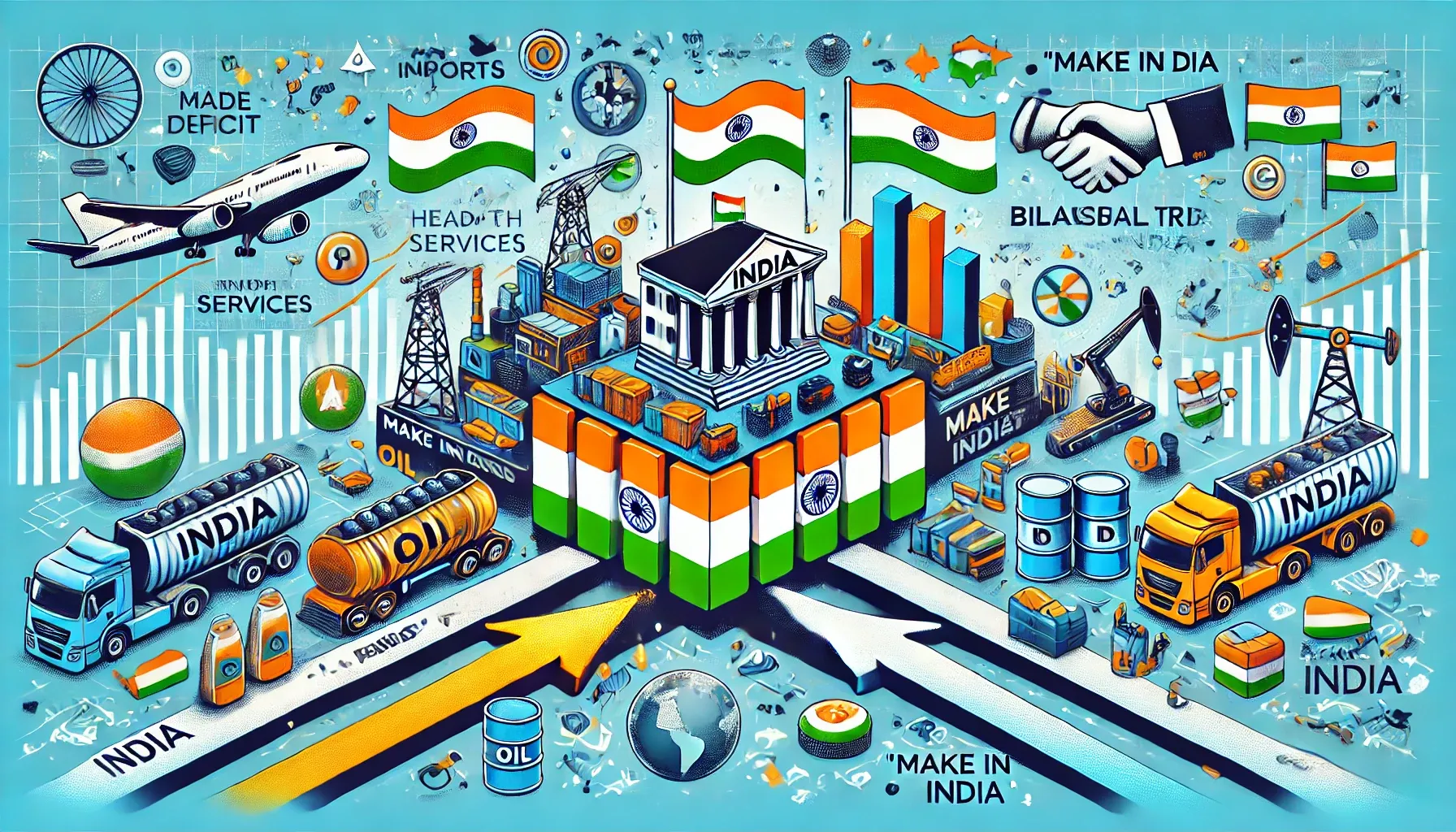India’s trade deficit reflects growing domestic demand and structural challenges like energy reliance and tech imports. Strategic policies, export diversification, and investments in renewable energy and manufacturing aim to balance trade and drive sustainable growth.

Introduction
India’s persistent trade deficit has long been a topic of debate in economic sittings, with both optimism and concern surrounding its implications for the nation's economic health. A trade deficit stretches its arm, when a country imports more goods and services than it exports, and for India, this imbalance is particularly pronounced in not good manner. As a rapidly growing economy, India’s imports far outweigh its exports, and is largely driven by the demand for energy resources, high-tech goods, and consumer products. However, while a trade deficit can be seen as an economic vulnerability, it also reflects the nation's expanding domestic demand, industrial needs, and long-term growth strategy.
What Is a Trade Deficit?
At its core, a trade deficit is a situation where a country imports more than it exports, creating an imbalance in the flow of goods and services. This phenomenon can be seen as both a sign of economic growth and a challenge that requires strategic management. In India’s case, the trade deficit primarily results from the import of energy resources like crude oil, along with technological products and machinery essential for industrial growth. While India is a global leader in several export sectors, such as IT services, pharmaceuticals, and textiles, these exports often do not fully offset the high import bill, particularly in the case of energy and technology.[1]
A deeper understanding of the trade deficit goes beyond mere numbers, as it provides deeper insight into the structural needs of India’s economy and provides that, if it is managed strategically then it can lead to long-term economic benefits.
The Roots of India’s Trade Deficit
India's trade deficit is a product of its evolving economic structure. Several key factors contribute to the trade imbalance, and understanding these elements is essential for addressing the issue effectively.
1. Strong Domestic Demand
India’s expanding middle class is one of the primary drivers of the trade deficit. As disposable incomes rise, consumer demand for a variety of goods, including electronics, automobiles, and household appliances has increased significantly. Many of these goods are imported, contributing directly to the trade deficit.[2] The demand for high-quality, often foreign-made products is expected to continue growing, further increasing India’s import dependency.
2. Energy Imports: The Crude Oil Conundrum
Energy imports play a crucial role in India’s trade deficit. As one of the largest importers of crude oil globally, India spends a significant portion of its foreign exchange on energy imports. Despite efforts to transition to renewable energy sources like solar and wind, the country remains heavily reliant on oil and gas to meet its growing energy demands.[3] Volatile global oil prices make this import bill unpredictable, which in turn exacerbates the trade deficit.
3. Dependence on High-Tech Imports
India has made significant progress in industrializing, yet it remains heavily dependent on imports for high-tech products. Electronics, machinery, and semiconductors items are being crucial for India’s technological and industrial development and are predominantly sourced from countries like China, South Korea, and Taiwan.[4] This dependency reflects gaps in domestic manufacturing capabilities, particularly in sectors like electronics and advanced machinery. As long as these gaps exist, India will continue to face substantial trade imbalances in these areas.
Policy Interventions: Strategic Rebalancing
India has undertaken several key policy interventions designed to strategically address its trade deficit and foster the growth of domestic manufacturing.[5] These measures focus on enhancing export performance, boosting local production capacities, and reducing reliance on imports. The primary goal is to create a balanced trade environment, where exports drive economic growth and manufacturing sectors are strengthened to meet both domestic and international demand.
A significant portion of these interventions involves financial incentives for export-oriented industries, the introduction of new export promotion schemes, and the establishment of industrial corridors aimed at improving connectivity and logistics. Furthermore, policies are being tailored to encourage technology-driven advancements in manufacturing, such as through the "Make in India" initiative, which aims to position India as a global manufacturing hub.
By addressing the underlying factors contributing to import dependency, such as the reliance on foreign raw materials and intermediate goods, India seeks to boost self-sufficiency in critical sectors. Additionally, the government is incentivizing innovation in sectors like electronics, textiles, and pharmaceuticals, with the goal of gradually reducing the trade deficit while simultaneously improving the country's global competitiveness.
1. The Production-Linked Incentive (PLI) Scheme
A key policy intervention aimed at addressing India’s trade deficit is the Production-Linked Incentive (PLI) scheme.[6] This initiative incentivizes domestic manufacturing in sectors like electronics, mobile phones, and textiles, thereby reducing India’s reliance on imports. By offering financial incentives to manufacturers, the scheme encourages them to set up production facilities within the country. This move not only creates jobs but also contributes to reducing import dependency.
2. Renewable Energy Investments
India’s push towards renewable energy is another strategic effort to reduce its energy import bill. By investing in solar, wind, and hydropower energy, India aims to reduce its reliance on imported crude oil and natural gas. The country's National Action Plan on Climate Change (NAPCC) focuses on expanding renewable energy capacity, and these efforts are expected to gradually decrease the country’s dependence on energy imports.[7] As India transitions to cleaner energy, its trade deficit will likely become more manageable over time.
3. Expanding Export Growth
In addition to addressing import dependency, India has been working to diversify and expand its export base. While traditional export sectors like textiles, IT services, and agriculture continue to perform well, there is a concerted effort to increase exports in emerging industries such as chemicals, engineering goods, and medical devices. By improving product competitiveness and global market access, India aims to boost its export revenues and narrow the trade deficit.
4. Bilateral Trade Agreements
India’s decision to withdraw from the Regional Comprehensive Economic Partnership (RCEP) in 2019 was a key strategic move to protect sensitive sectors from increased competition, particularly from China. Instead, India has focused on negotiating bilateral trade agreements with countries such as Japan, Australia, and the UAE.[8] These deals are designed to benefit India's core industries while safeguarding its agricultural and manufacturing sectors from potentially harmful imports.
Export Growth: Harnessing Untapped Potential
India’s export sector has significant potential for growth, especially in emerging industries where the country has a competitive edge.
1. Pharmaceutical Exports
India is the world’s largest producer of generic medicines, and its pharmaceutical industry is a crucial component of the country’s export strategy.[9] With healthcare demands rising globally, India’s pharmaceutical sector is poised for further growth. By leveraging its strengths in producing high-quality, cost-effective medicines, India can expand its pharmaceutical exports and continue to play a major role in global healthcare.
2. Engineering Goods and Chemicals
India’s manufacturing sector, particularly in the areas of engineering goods, machinery, and automotive components, is becoming increasingly competitive on the global stage. Additionally, India’s chemical industry, which produces fertilizers, petrochemicals, and specialty chemicals, is also seeing rising demand from international markets. Expanding exports in these sectors will help balance the trade deficit and drive economic growth.
India and the RCEP: A Pragmatic Choice
India’s decision to exit the Regional Comprehensive Economic Partnership (RCEP) in 2019 was a calculated move to protect its sensitive sectors from the challenges posed by the agreement. The RCEP, which includes China and several Southeast Asian countries, was expected to open up Indian markets to cheaper imports, which could harm domestic industries like agriculture and textiles.[10] Instead of fully embracing the partnership, India chose to negotiate bilateral trade agreements where it could secure more favorable terms for its industries and protect its economic interests. This pragmatic approach ensures that India maintains control over its trade policy while also participating in global trade in a way that benefits its economy.
Opportunities in the Deficit
Despite the challenges presented by a trade deficit, India’s situation still offers several opportunities with wide aspects. The capital goods imported into India, such as machinery and technology, are essential for upgrading the country’s industrial base, these imports help modernize infrastructure, which in turn facilitates higher productivity and future export growth. Moreover, India’s rapidly growing digital economy and its vibrant e-commerce sector provide a platform for new and innovative avenues for small and medium-sized enterprises (SMEs) to tap into global markets. As India continues to invest in renewable energy, electric vehicles, and green technologies, these sectors present a promising future for reducing energy imports and increasing exports.
The Path to Balance
To achieve a more balanced trade position, India needs to continue implementing strategic interventions across multiple fronts. Enhancing domestic manufacturing capabilities, particularly in high-tech industries, is crucial for reducing reliance on imports. The country must also focus on diversifying its export portfolio, expanding into emerging sectors like renewable energy and electric vehicles. Furthermore, India should continue to negotiate favorable bilateral trade deals that offer more protection for its key industries while opening up new markets for its goods. By creating a more resilient and diversified economy, India can reduce its trade deficit and position itself as a more competitive player in global markets.
Conclusion
India’s trade deficit, though substantial, should not be seen as an economic weakness but rather as a reflection of its rapid industrialization and structural challenges. The deficit represents an opportunity for India to strengthen its manufacturing base, expand exports, and reduce its dependency on foreign imports. Through strategic policy interventions, investments in renewable energy, and a focus on export diversification, India can achieve a more balanced trade future. By addressing the root causes of the deficit and tapping into emerging industries, India can ensure that its economic growth remains sustainable and robust in the long term.
[1] VIKSIT: An approach for India to achieve USD 1 trillion exports
[3] Press Note Details: Press Information Bureau
[5] Press Release: Press Information Bureau
[7] Climate Change Programme | Department Of Science & Technology
[8] Brief on Regional Comprehensive Economic Partnership (RCEP) - Mcommerce
[9] Indian Pharmacy: Pharma Companies in India | IBEF
[10] India’s RCEP exit and its regional future | East Asia Forum


